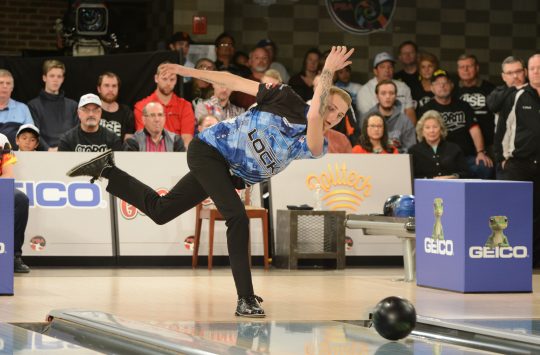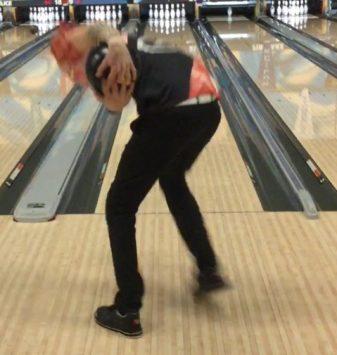The Jesper Svensson Paradox: Old-School Lessons from a Two-Hander's Game

BY BILL SPIGNER
 Jesper's hand position is unusual, with his fingers interlocking, as is the big gap between his feet on his pivot step. The ball is behind his right shoulder, yet still outside of his left hip so the ball has space to drop down to the release zone.
Jesper's hand position is unusual, with his fingers interlocking, as is the big gap between his feet on his pivot step. The ball is behind his right shoulder, yet still outside of his left hip so the ball has space to drop down to the release zone.
The professional bowling world is really going through a changing of the guard. For a while, the more experienced players were ruling the lanes, but that sure has changed in the past year, with a young phenom, Jesper Svensson, helping to lead the charge.
Jesper is the most interesting bowler in the world today. His left-handed two-handed style is different than a lot of others, as we are seeing a variety of styles among the two-handers, just as we did for decades with “one-handed” bowlers. It’s exciting as a coach to watch the evolution of the two-handed styles. With the masses of youth bowlers buying into the formerly unique delivery, the future is certainly going to be interesting.
Looking at Jesper’s game, his set-up looks pretty normal: feet staggered a little, ball held below his waist, his right arm fairly straight, and some bend in his left arm. That’s similar to other two-handers, but that also is where the similarities end.
The fingers of his right hand are spread out and the index, middle and ring fingers of his bowling hand go between the tips of the index, middle, ring and pinky fingers of his non-bowling hand, as if they were woven together. He is the only bowler I have seen do this to support the ball.
The start of his approach also is different, as he has no pushaway. At the completion of the second step of his five-step approach, he straightens out both arms and the ball moves down just a little because his forward spine tilt has increased.
On his third step, the ball has started going back, but only because his forward spine tilt has increased from 10 degrees in his stance to about 70 degrees at the end of step three. So he is basically using no swing during his first three steps. The ball is almost in its starting position for three steps, and he is walking past the ball; the only reason it gets behind him for a simulated swing is his forward spine tilt — another thing that I have seen only him do.
Jesper’s fourth step is very short, which is common among two-handers because of the forward and side spine tilt. This helps him get farther ahead of the swing entering the last step.
He has a long slide, about 2 feet, and his slide foot stops with the ball about 18 inches behind the slide foot. With the foot stopped, the body is set up to receive the ball for the release. His spine tilt at release is about 75 degrees, which is 5 degrees more than it was at the end of step three.
 Jesper's release starts well above his ankle with the ball under his right shoulder. He then releases the ball out in front of him well out onto the lane, with the ball going down into the lane like a plane landing.
Jesper's release starts well above his ankle with the ball under his right shoulder. He then releases the ball out in front of him well out onto the lane, with the ball going down into the lane like a plane landing.
Jesper has some unique footwork. Looking from behind, his first two steps go straight ahead. Step three goes about four boards to the right, which is okay. But on step four, the toe of his left foot goes about eight boards left, and the foot turns sideways. Going sideways with the foot on this step is normal for two-handers because of the upper-body tilt and the hip and shoulder rotation to produce a swing.
This step also creates a separation of about 17 boards between the toes of both feet, which is quite unusual. For most bowlers, a second-to-last step like that would have them walking in front of the swing, creating downswing issues. Jesper’s swing remains outside his left hip, and he has plenty of space for his downswing to tuck in for the release.
Jesper’s release and power are the big things that have made him famous. For a player with speed and revs like his, you’d think he’d be a monster hook guy with accuracy problems. But he’s quite the opposite; he plays straighter lines and is deadly accurate.
He uses a minimal amount of turn with his fingers, turning them from about 5 o’clock to only about 7 o’clock. Once that turn is done, his wrist releases/unloads and the fingers go straight up the ball, exiting the top of the ball at 11 o’clock. He gets enough axis rotation and tilt so the ball has a continuous arc to it.
At the start of Jesper’s release, the ball is well inside of his head. It’s actually under his right shoulder because of his 85-degree lateral spine tilt. His hand goes straight up from the start of his release and passes in front of his right shoulder. It looks like the hand is going right a lot and pulling the ball when, in reality, it is not.
Jesper also has a high leg kick with his non-sliding foot, which is very old school. We see a lot of release and finish positions today with the trail leg’s foot remaining in contact with the floor. Jesper remains remarkably well balanced on one leg, and when his trail foot descends to the floor, it goes straight down to a posted position, rarely falling off to his left. It takes a lot of strength to stay balanced, get as much speed, and get as many revs on the ball as he does from a short swing and the body position he has at the release.
Playing on the left side as Jesper does, it’s important to play straighter lines because the pattern in the mid-lane doesn’t change its shape as much as on the right side. It’s also important on the left side to play the mid-lane of the pattern because that’s where the greatest blend in the oil is.
Jesper uses urethane almost exclusively, with dull surfaces that enable his ball to read the pattern in the mid-lane and create some area. If he were to use resin urethane, the ball would slide longer and miss being able to read the pattern in the mid-lane.
 Jesper's finish position shows his arm and hand finishing right of his head in front of his right shoulder. The elbow and palm are facing back toward him, showing he has released through the ball and not around it. That enables him to project the ball in a straight line down the lane.
Jesper's finish position shows his arm and hand finishing right of his head in front of his right shoulder. The elbow and palm are facing back toward him, showing he has released through the ball and not around it. That enables him to project the ball in a straight line down the lane.
His lengthwise adjustments are critical because he has to play a narrow part of the lane. When the ball starts hooking a little early, he can’t move in much because of the limited traffic on the left side, so he has to project the ball farther down the lane, and that’s where his speed really comes in handy.
Like most left-handers, Jesper concerns himself with the front-to-back adjustments that need to be made in order to play the part of the lane that’s required by the pattern without moving out of the zone they’re in. Playing the lanes straighter and concentrating on playing the pattern correctly in the mid-lane is good advice for any left-hander to follow, especially on tougher patterns.
Jesper is changing the thinking of equipment use by the two-handers, no-thumbers and high-rev players, as more and more are using urethane more often, especially on fresh conditions. It has taken a bowler barely old enough to enjoy an adult beverage to demonstrate the value of old-school bowling: playing the lanes straighter, and staying on top of the pattern in the mid-lane and not the back end.
It really showed when he won the PBA’s FireLake Tournament of Champions in early February. By the end of that event, a good number of players were using urethane on the fresh.
LESSON PLAN
Jesper Svensson is the most interesting bowler in the world because of all the things he does that are different.
The two-handed style that he embraced at a very young age wasn’t being taught at the time, and it’s common that coaches will try to change what they see as being out of the ordinary. Jesper stuck to his guns and refined his game on his terms.
Every bowler’s game has a certain personality. The important thing to remember is to do what’s natural for you, and work to refine the core elements of your game. There have been many successful bowlers who do things contrary to what would be considered “textbook.”
There are certain core principles every bowler needs: consistency; a fluid, well-timed delivery (timing is relative to the individual’s game); good balance; and the ability to project the ball down the lane in the correct direction, and with the action needed on the ball.
Jesper’s self-taught physical game has all the core principles. Work on your game. Don’t try to make yours like someone else’s.
Bill Spigner is a Gold coach and member of the Team USA coaching team. The above story was the May 2016 edition of his instructional column, "The Pro Approach," which appears bimonthly in Bowlers Journal International. To subscribe now for much more of the industry's best coverage of bowling news and incisive instructional tips and analysis, go here: /bowlers-journal-subscriptions/





